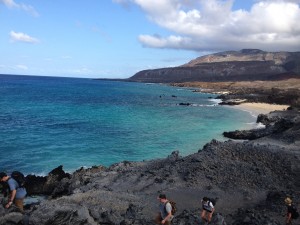Ascension Island is a 36 square mile island in the South Atlantic Ocean, stationed approximately 700 miles from the nearest land – St. Helena, site of Napoleon Bonaparte’s exile. Its profound geographic isolation makes one wonder how such a place was discovered and how it came to be significant? These questions were answered for us on a trip down the road to the Ascension Island Heritage Museum and Gallery. This small museum was chock full of fascinating photos and artifacts documenting the island’s historical and cultural relevance.
We were surprised to learn that the British were not the first to discover and claim the island. It was actually discovered by a Portuguese explorer in 1501 and initially named Conception. A few years later, it was given its current name Ascension and chartered as part of the Portuguese empire in 1539. However, it remained uninhabited until 1815 when the British claimed it as their own, establishing a military presence that continues to today.
While Ascension Island was primarily military, it had several other historical purposes. The father of evolution, Charles Darwin, visited the island in 1836 as part of his voyage on the HMS Beagle. Records show that he described the island as a “huge ship kept in first rate order” and that his astonishment at the natural landscape renewed his enthusiasm for geology. He, along with Joseph Hooker, helped create the man-made cloudforest on Green Mountain by facilitating the introduction of non-native species – a site that we are excited to visit later on this trip.
While Ascension’s migratory green turtles had been harvested since the establishment of the island, the turtle industry boomed in the early 20th century. Turtles were collected and kept in turtle “ponds” to be kept fresh until passing ships came to pick them up and delivered back to England. This process died down in the 1940’s – and to this day, turtles are no longer a commercial industry on the island.
Ascension also played a significant role in worldwide communications. Its strategic position in the middle of the South Atlantic allowed one of the earliest telegraph cables to be laid, connecting Cape Town, South Africa, to the U.S. via the island. The BBC has a radio presence that continues to this day, broadcasting news and information to both Africa and the Americas from huge towers stationed across the island. Additionally, the island has served NASA as a tracking station. In fact, Ascension was the first place to receive Neil Armstrong’s famous words, “That’s one small step for man, one giant leap for mankind.” The island is incidentally host to one of the largest landing strips in the world, which would have provided a site for the NASA space shuttle to land in the case of an emergency.
After learning a lot about the history of Ascension, we were able to engage with current inhabitants and other visitors. We participated in one of the island’s weekly group hikes, called a “hash,” organized by the local group the Hash Harriers. Together, we hiked a couple of rigorous miles over a rocky lava field to this week’s destination, Porpoise Point, where we had an amazing view of the ocean and surrounding landscape.
Following our trek, we were rewarded with a lovely barbeque and potluck, graciously hosted by members of the community. There we had the opportunity to socialize with those living on the island, many of whom generously shared with us their own personal stories as to what brought them here. As a whole, this day provided us with great insight into the past and present day history and culture of the island, further enriching this incredible experience.


